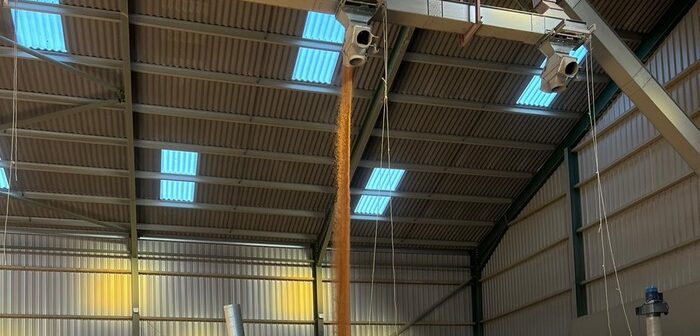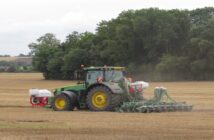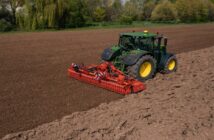The pulling of milk contracts in the Aberdeen area by a large diary meant that Roy Mitchell of Lofthillock Farm, Inverurie, Aberdeen, had some tough decisions to make. After much soul-searching, Mitchell decided that his dairy herd had to go, he would finish some beef cattle and significantly increase his arable output which would require an upgrade of the farm’s existing grain handling capabilities.
“Previously, the crops were used to feed the cows but increasing my arable to 70ha of winter barley, 80ha of winter wheat, 50ha of oilseed rape and 130ha of spring barley presented a big challenge,” explained Mr Mitchell.
Over the years Mitchell had hired different makes of batch driers during harvest but there had been no need to invest in a drier of his own.
No storage facilities
“I didn’t have the drying or storage facilities, or the staff to be able to handle my increased grain tonnage,” added Mr Mitchell. “I had one large grain store and a telehandler but nothing else in place for harvest 2021. Using a contractor for combining, I am not always able to pick and choose the incoming moisture content (mc) – which in this area is historically higher than other parts of the UK, so I had to find a solution pretty quickly.”
After doing some research and talking to other farmers, Mr Mitchell decided that his best option was a modern 30t batch capacity drier from Master Farm Services as its driers had a proven record in terms of drier technology and build quality. Plus, the high residual values and flexibility of batch driers appealed to Mitchell having just experienced how quickly the farming landscape can change.
Following conversations with George Young of Master Farm Services it was clear that its Master drier integrated with Skandia Elevator handling equipment, supplied by BDC Systems Ltd, and installed by Ravenhill would meet Mr Mitchell’s requirements, importantly, at the right price.
John Wilson, BDC Systems’, area manager, Scotland and North East England advised Master Farm Services’ Young on the design of the upgraded plant and the choice of Skandia handling equipment to match the capability of the Master drier.
“It was key that we supplied the right intake to, and discharge from, the drier to maximise the drying and handling process,” explained Mr Wilson. “We based everything around installing 80tph Skandia I-Line equipment.”
Mr Mitchell’s plant includes a large shed to hold the wet grain, this is then tipped into a 12m Skandia trench intake (KTIG30/40) which feeds the intake hopper of the 30t Master drier. With the Skandia intake capacity at 80tph and the drier intake auger at 90tph, there is no chance of overloading. Filling the drier, which has an excellent dust extraction system with an additional gravity cleaner fan, at this rate maximises the drier’s daily throughput.
“The drier’s dust extraction and cleaning features are giving me an average of five points on my bushel weight, which is extremely helpful,” stated Mitchell.
From the drier, grain is transported to the grain store via an inclined 8m Skandia 80tph chain and flight conveyor (KTIA30/40). Two more 80tph Skandia chain and flight conveyors (KTIF30/33) one being 14m, the other 26m long, take the grain to two separate stores. The store conveyors are fitted with R&P remote slide outlets with three-way and two-way valves allowing grain to fill either stores one or two.
“The upgraded plant has been a huge success. I have avoided employing additional harvest staff, helping the bottom line, and although the 2022 season was one of our easiest, the drier came into its own with its excellent cooling and cleaning capabilities,” added Mitchell, who believes that return on investment (RoI) around the upgraded plant will be pretty quick.
“The biggest saving for me will be in the potential losses I would experience if I had to sell the grain straight off the combine, or put it into a commercial store for drying and storage. With the high mc we experience here, it doesn’t take long for any profits to be wiped out if you can’t dry and store your own grain,” Mitchell said.
Additionally, Mr Mitchell has the ability to market his grain to whom he wants when he wants, which will also speed up RoI. The improvement in bushel weight is also a factor as potential buyers see the benefit that batch driers can deliver in terms of grain quality.
“As a one-man band, I would highly recommend a plant which consists of a batch drier combined with Skandia handling equipment. It has significantly reduced grain handling and is very easy to operate.
“Of course, you need to work with grain handling experts to make sure that all the different drying and grain handling components work together. Master Farm Services, BDC Systems and Ravenhill are the people to talk to. They are happy to put you in touch with their customers so you can talk farmer to farmer about what works best.
“By working closely together, the three companies have delivered an upgraded grain processing plant which has hugely reduced my stress levels during harvest and that is priceless,” concluded Mitchell.
NB: Master Farm Services is holding an Open Day hosted by Roy Mitchell at Lofthillock Farm, Keithhall, Inverurie, Aberdeen, on Thurs 9 March. BDC Systems’ John Wilson will be on hand to discuss all things grain handling.




